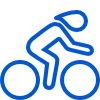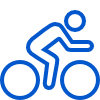The Benefits – And Dangers – Of Filtering
Being able to “filter” can be one of the main benefits of riding a bike, particularly if you are commuting to and from work during busy rush hour traffic.
For the uninitiated, “filtering” is just the technical description for overtaking slower-moving traffic.
You might find yourself cycling home when you come across a queue of stationary traffic ahead of you, potentially spanning more than one lane. This raises the questions can you overtake it and, if so, how?
As a cyclist, you must obey the rules of the road. These dictate that if there are double white lines on the road or “no overtaking” signs in place, you must not filter.
Similarly, you must cycle with due care and attention and not dangerously. As long as you follow those rules, filtering is legal.
Cyclists have the benefit of being extremely manoeuvrable compared to other road users and also have excellent visibility.
However, as a cyclist you are also extremely vulnerable. When filtering, you place your faith in other road users, trusting that they will see you and not do anything to endanger you.
You should take the usual precautions to maximise your chances of being seen –including wearing high-visibility clothing and fitting lights and reflectors.
Confidence is key. If you are not particularly confident, sometimes the safest option is to “take the lane”.
This means to place yourself in the centre of the lane you are travelling in and to hold that position, waiting in the queue along with the other traffic.
Do not “hug the kerb”, as this might invite other road users to try to squeeze past you.
If you do decide to filter, often the most intuitive way is to filter on the left of the stationary or slow-moving traffic (that is, between the cars and the kerb).
Do not do this. Although it might feel intuitive, it is actually a very dangerous place to be. Most drivers don’t expect to be overtaken on that side of their vehicle, and although they should check their passenger side mirror, many do not.
You run the risk of a passenger opening a car door suddenly into your path, or a vehicle turning suddenly to their left without the driver checking their mirror.
Filtering along this side of HGVs is especially dangerous as the driver may not be able to see you at all, even if they are using their mirrors.
If there are multiple lanes travelling in the same direction, you could choose to filter between those lanes.
This is safer than filtering on the left, as there is far less chance of a door suddenly opening into your path. However, it is not completely without risk.
Vehicles might suddenly change lanes across your path without checking their mirrors first, or might inadvertently “close the gap”, leaving you with insufficient room to pass.
Filtering on the outside (that is, in the centre of the road) is often the safest choice, as long as there isn’t a continuous centre line painted on the road.
If there is a continuous centre line, you must not filter. You will need a high level of confidence to cycle in this position and will have to constantly read the road conditions.
However, when done safely, you will be visible to other road users and run much less chance of a vehicle closing the gap, and almost no chance of a door opening suddenly into your path.
You should constantly scan ahead for “refuges”, or gaps in the traffic travelling in your direction into which you can slot your bike after overtaking a few cars.
Do not attempt to filter on the outside of any vehicle indicating its intention to turn right. If you do so, there is a very real chance the vehicle might turn into you as you are passing.
Once the congestion has cleared, and the traffic is flowing at the same speed or faster than you are, you should stop filtering and return to your primary road position.
The British Cycling website offers further detailed explanation of how to safely filter with explanatory diagrams –
https://www.britishcycling.org.uk/knowledge/skills/article/izn20130830-Effective-traffic-riding-part-2-0

Cycle Compensation
Our specialist lawyers have recovered millions of pounds on behalf of injured claimants and will guide you through your cycle claim.

Cycle Repairs
Recovering the full cost of getting your bike repaired or replaced, so you can get back on the road as soon as possible.

Rehabilitation
To alleviate pain, help you return to work or get back on your bike. We will help you make the best recovery possible.
